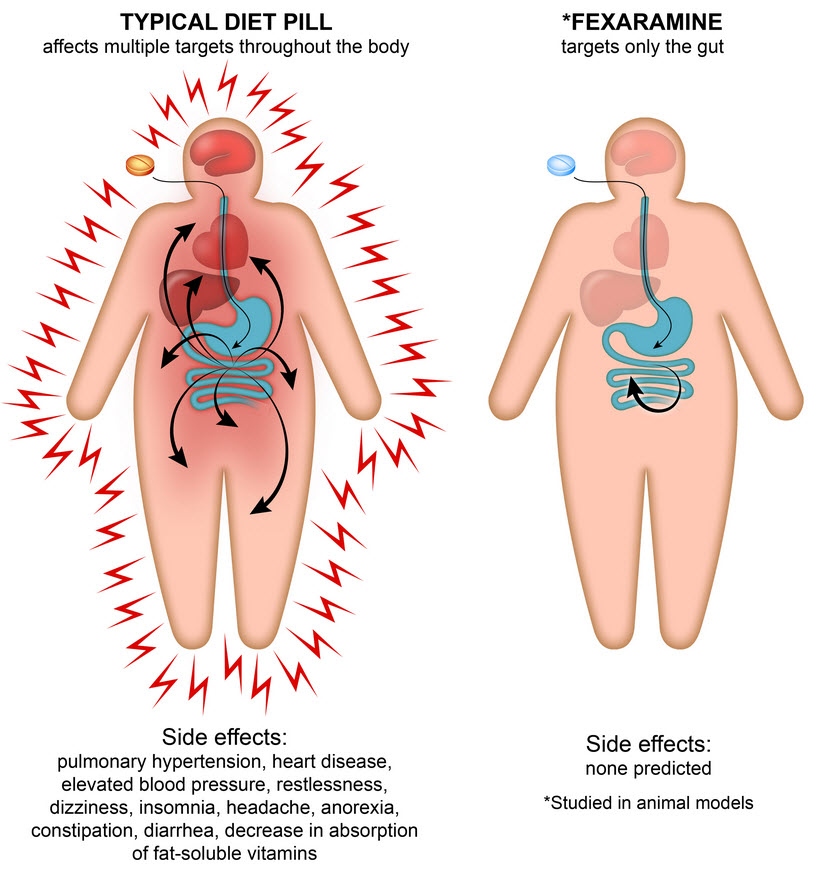‘Imaginary meal’ tricks the body into losing weight
January 5, 2015

Ronald Evans, director of Salk’s Gene Expression Laboratory, has developed a compound called fexaramine that acts like an imaginary meal: It tricks the body into reacting as if it has consumed calories, and could lead to an effective obesity and diabetes treatment in humans (credit: Courtesy of the Salk Institute for Biological Studies)
Salk researchers have developed an entirely new type of pill that tricks the body into thinking it has consumed calories, causing it to burn fat.
The compound effectively stopped weight gain, lowered cholesterol, controlled blood sugar, and minimized inflammation in mice, making it an excellent candidate for a rapid transition into human clinical trials.
Unlike most diet pills on the market, this new pill, called fexaramine, doesn’t dissolve into the blood like appetite suppressants or caffeine-based diet drugs, but remains in the intestines, causing fewer side effects.
“This pill is like an imaginary meal,” says Ronald Evans, director of Salk’s Gene Expression Laboratory and senior author of the new paper, published today (January 5) in Nature Medicine. “It sends out the same signals that normally happen when you eat a lot of food, so the body starts clearing out space to store it. But there are no calories and no change in appetite.”
Evans’ laboratory has spent nearly two decades studying the farensoid X receptor (FXR), a protein that plays a role in how the body releases bile acids from the liver, digests food and stores fats and sugars. The human body turns on FXR at the beginning of a meal, Evans and others have shown, to prepare for an influx of food. FXR not only triggers the release of bile acids for digestion, but also changes blood sugar levels and causes the body to burn some fats in preparation for the incoming meal.
In the United States, more than a third of adults are obese and 29.1 million people have diabetes, according to the Centers for Disease Control and Prevention. Both obesity and diabetes lead to an increase in health spending, a greater risk of health complications, and a shorter lifespan.
“When you eat, you have to quickly activate a series of responses all throughout the body,” says Evans. “And the reality is that the very first responder for all this is the intestine.”
Evans and his colleagues developed the fexaramine compound by departing from the drug scaffold that most pharmaceutical companies typically pursue when targeting FXR. Pharmaceutical companies aiming to treat obesity, diabetes, liver disease and other metabolic conditions have developed systemic drugs that activate FXR, turning on many pathways that FXR controls. But these drugs affect several organs and come with side effects. Evans wondered whether switching on FXR only in the intestines — rather than the intestines, liver, kidneys and adrenal glands all at once — might have a different outcome.
Fooling the body
“It turns out that when we administer this orally, it only acts in the gut,” explains Michael Downes, a senior staff scientist at Salk and co-corresponding author of the new work. Giving one such drug in a daily pill form that only reaches the intestines — without transporting into the bloodstream that would carry the drug throughout the body — not only curtailed side effects but also made the compound better at stopping weight gain.

Salk researchers demonstrated that fexaramine stops weight gain and burns fat in animal models. Fexaramine is only absorbed in the gut and does not go into the bloodstream, so it does not cause side effects common for typical diet pills. After additional testing, researchers believe this will lead to an effective weight-loss diabetes treatment for humans. (Credit: Salk Institute for Biological Studies)
When the group gave obese mice a daily pill of fexaramine for five weeks, the mice stopped gaining weight, lost fat and had lower blood sugar and cholesterol levels than untreated mice. In addition, the mice had a rise in body temperature — which signals metabolism ramping up — and some deposits of white fat in their bodies converted into a healthier, energy-burning beige form of the tissue. Even the collection of bacteria in the guts of mice shifted when they received the drug, although what those changes mean isn’t clear yet.
So, why does fexaramine in the intestines work even better than drugs that simultaneously activate FXR throughout the body? Evans thinks it has to do with the natural order in which the body’s molecular pathways normally responds to a meal.
“The body’s response to a meal is like a relay race, and if you tell all the runners to go at the same time, you’ll never pass the baton,” says Evans. “We’ve learned how to trigger the first runner so that the rest of the events happen in a natural order.”
Since fexaramine doesn’t reach the bloodstream, it is also likely safer in humans than other FXR-targeting drugs, the researchers hypothesize. They’re already working to set up human clinical trials to test the effectiveness of fexaramine to treat obesity and metabolic disease. Ideally, the drug, administered under a doctor’s guidance, would work in conjunction with diet and lifestyle changes, similar to weight-loss surgeries or other obesity or diabetes drugs.
Researchers at the University of Michigan; the University of California, San Diego; the École Polytechnique Fédérale de Lausanne; and the University of Sydney were also involved.
he work was supported by grants from the National Institutes of Health, Glenn Foundation for Medical Research, Leona M. and Harry B. Helmsley Charitable Trust, Ipsen Bioscience, California Institute for Regenerative Medicine, the Ellison Medical Foundation and the National Health and Medical Research Council of Australia. Ronald Evans also receives funding from the Howard Hughes Medical Institute.
Salk Institute | Fexaramine Tricks Mice Into Losing Weight
Abstract for Intestinal FXR agonism promotes adipose tissue browning and reduces obesity and insulin resistance
The systemic expression of the bile acid (BA) sensor farnesoid X receptor (FXR) has led to promising new therapies targeting cholesterol metabolism, triglyceride production, hepatic steatosis and biliary cholestasis. In contrast to systemic therapy, bile acid release during a meal selectively activates intestinal FXR. By mimicking this tissue-selective effect, the gut-restricted FXR agonist fexaramine (Fex) robustly induces enteric fibroblast growth factor 15 (FGF15), leading to alterations in BA composition, but does so without activating FXR target genes in the liver. However, unlike systemic agonism, we find that Fex reduces diet-induced weight gain, body-wide inflammation and hepatic glucose production, while enhancing thermogenesis and browning of white adipose tissue (WAT). These pronounced metabolic improvements suggest tissue-restricted FXR activation as a new approach in the treatment of obesity and metabolic syndrome.